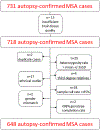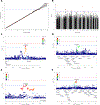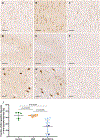Common Variants Near ZIC1 and ZIC4 in Autopsy-Confirmed Multiple System Atrophy
- PMID: 35997131
- PMCID: PMC10052809
- DOI: 10.1002/mds.29164
Common Variants Near ZIC1 and ZIC4 in Autopsy-Confirmed Multiple System Atrophy
Abstract
Background: Multiple System Atrophy is a rare neurodegenerative disease with alpha-synuclein aggregation in glial cytoplasmic inclusions and either predominant olivopontocerebellar atrophy or striatonigral degeneration, leading to dysautonomia, parkinsonism, and cerebellar ataxia. One prior genome-wide association study in mainly clinically diagnosed patients with Multiple System Atrophy failed to identify genetic variants predisposing for the disease.
Objective: Since the clinical diagnosis of Multiple System Atrophy yields a high rate of misdiagnosis when compared to the neuropathological gold standard, we studied only autopsy-confirmed cases.
Methods: We studied common genetic variations in Multiple System Atrophy cases (N = 731) and controls (N = 2898).
Results: The most strongly disease-associated markers were rs16859966 on chromosome 3, rs7013955 on chromosome 8, and rs116607983 on chromosome 4 with P-values below 5 × 10-6 , all of which were supported by at least one additional genotyped and several imputed single nucleotide polymorphisms. The genes closest to the chromosome 3 locus are ZIC1 and ZIC4 encoding the zinc finger proteins of cerebellum 1 and 4 (ZIC1 and ZIC4).
Interpretation: Since mutations of ZIC1 and ZIC4 and paraneoplastic autoantibodies directed against ZIC4 are associated with severe cerebellar dysfunction, we conducted immunohistochemical analyses in brain tissue of the frontal cortex and the cerebellum from 24 Multiple System Atrophy patients. Strong immunohistochemical expression of ZIC4 was detected in a subset of neurons of the dentate nucleus in all healthy controls and in patients with striatonigral degeneration, whereas ZIC4-immunoreactive neurons were significantly reduced inpatients with olivopontocerebellar atrophy. These findings point to a potential ZIC4-mediated vulnerability of neurons in Multiple System Atrophy. © 2022 The Authors. Movement Disorders published by Wiley Periodicals LLC on behalf of International Parkinson and Movement Disorder Society.
Keywords: ZIC1; ZIC4; autopsy-confirmed; genome-wide association study; multiple system atrophy.
© 2022 The Authors. Movement Disorders published by Wiley Periodicals LLC on behalf of International Parkinson and Movement Disorder Society.
Conflict of interest statement
Figures



Similar articles
-
Progressive striatonigral degeneration in a transgenic mouse model of multiple system atrophy: translational implications for interventional therapies.Acta Neuropathol Commun. 2018 Jan 3;6(1):2. doi: 10.1186/s40478-017-0504-y. Acta Neuropathol Commun. 2018. PMID: 29298733 Free PMC article.
-
Somatic SNCA Copy Number Variants in Multiple System Atrophy are Related to Pathology and Inclusions.Mov Disord. 2023 Feb;38(2):338-342. doi: 10.1002/mds.29291. Epub 2022 Nov 30. Mov Disord. 2023. PMID: 36448620
-
Multiple developmental programs are altered by loss of Zic1 and Zic4 to cause Dandy-Walker malformation cerebellar pathogenesis.Development. 2011 Mar;138(6):1207-16. doi: 10.1242/dev.054114. Epub 2011 Feb 9. Development. 2011. PMID: 21307096 Free PMC article.
-
The neuropathology, pathophysiology and genetics of multiple system atrophy.Neuropathol Appl Neurobiol. 2012 Feb;38(1):4-24. doi: 10.1111/j.1365-2990.2011.01234.x. Neuropathol Appl Neurobiol. 2012. PMID: 22074330 Review.
-
Multiple system atrophy: alpha-synuclein and neuronal degeneration.Neuropathology. 2007 Oct;27(5):484-93. doi: 10.1111/j.1440-1789.2007.00841.x. Neuropathology. 2007. PMID: 18018485 Review.
Cited by
-
Multiple system atrophy: at the crossroads of cellular, molecular and genetic mechanisms.Nat Rev Neurosci. 2023 Jun;24(6):334-346. doi: 10.1038/s41583-023-00697-7. Epub 2023 Apr 21. Nat Rev Neurosci. 2023. PMID: 37085728 Review.
-
Prioritizing disease-related rare variants by integrating gene expression data.PLoS Genet. 2024 Sep 30;20(9):e1011412. doi: 10.1371/journal.pgen.1011412. eCollection 2024 Sep. PLoS Genet. 2024. PMID: 39348415 Free PMC article.
-
A multiplex pedigree with pathologically confirmed multiple system atrophy and Parkinson's disease with dementia.Brain Commun. 2022 Jul 4;4(4):fcac175. doi: 10.1093/braincomms/fcac175. eCollection 2022. Brain Commun. 2022. PMID: 35855480 Free PMC article.
-
Genome sequence analyses identify novel risk loci for multiple system atrophy.Neuron. 2024 Jul 3;112(13):2142-2156.e5. doi: 10.1016/j.neuron.2024.04.002. Epub 2024 May 2. Neuron. 2024. PMID: 38701790
-
An update on multiple system atrophy.Curr Opin Neurol. 2024 Aug 1;37(4):400-408. doi: 10.1097/WCO.0000000000001285. Epub 2024 Jun 3. Curr Opin Neurol. 2024. PMID: 38828714 Review.
References
-
- Fanciulli A, Stankovic I, Krismer F, Seppi K, Levin J, Wenning GK. Multiple system atrophy. Int Rev Neurobiol 2019;149:137–192. - PubMed
-
- Schrag A, Wenning GK, Quinn N, Ben-Shlomo Y. Survival in multiple system atrophy. Mov Disord 2008;23(2):294–296. - PubMed
-
- Klockgether T, Ludtke R, Kramer B, et al. The natural history of degenerative ataxia: a retrospective study in 466 patients. Brain 1998;121(Pt 4):589–600. - PubMed
Publication types
MeSH terms
Substances
Grants and funding
- U24 AG021886/AG/NIA NIH HHS/United States
- U01 AG032984/AG/NIA NIH HHS/United States
- MR/L016451/1/MRC_/Medical Research Council/United Kingdom
- U01 AG016976/AG/NIA NIH HHS/United States
- P50 NS053488/NS/NINDS NIH HHS/United States
- P50 AG005136/AG/NIA NIH HHS/United States
- U24 AG041689/AG/NIA NIH HHS/United States
- P01 AG066597/AG/NIA NIH HHS/United States
- P30 AG066509/AG/NIA NIH HHS/United States
- U54 NS110435/NS/NINDS NIH HHS/United States
- U24 NS120854/NS/NINDS NIH HHS/United States
- P30 AG072979/AG/NIA NIH HHS/United States
- K08 AG065463/AG/NIA NIH HHS/United States
- P30 AG010124/AG/NIA NIH HHS/United States
- P30 AG072977/AG/NIA NIH HHS/United States
- U19 AG062418/AG/NIA NIH HHS/United States

